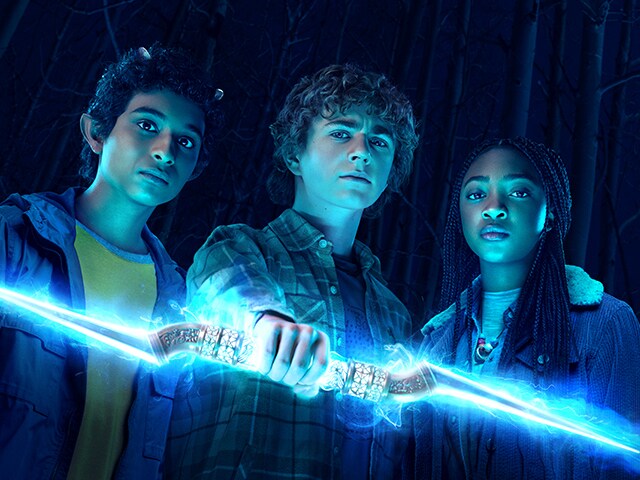Look, I didn’t want to write this article. If you’re reading this thinking that you might want to write one, my advice is to close this page right now.
Being a staff writer on the Mirror is dangerous. It’s scary. Most of the time it gets you writing about one of your favorite book series that just got adapted into a Disney+ show.
Don’t say I didn’t warn you.
On June 28, 2005, the world of young-adult fiction was forever changed with the release of “Percy Jackson and the Olympians: The Lightning Thief,” by Rick Riordan, a modern reinvention of and homage to Greek mythology.
“The Lightning Thief” follows the story of 12-year-old Percy Jackson, a “troubled kid” who can’t seem to stay in one school for more than a year.
His life is forever changed when he discovers that he is a “demigod,” the son of the Greek god Poseidon.
Percy learns he must go on a quest across the country to find the thief of Zeus’s “master lightning bolt,” in order to prevent a war among the gods, while battling monsters straight out of Greek mythology that are determined to kill him.
The books quickly gained popularity, and the Percy Jackson fandom flourished, casting cultural influence over numerous generations of young readers with its personable, snappy narration, interesting story and creative new interpretation of Greek mythology.
Desperate for a visual representation of this magical world of Greek myths, fans were overjoyed to hear that the series would be made into a movie in 2010, with Logan Lerman, Alexandria Daddario and Brandon T. Jackson. However, when the movie adaptation of the first novel was released, many of these fans were violently disappointed.
Although a cult classic of many, the film’s blatant ignorance of the source material, terrible CGI, and “Hollywood-ified” changes, placed it on many lists of worst book-to-movie adaptations ever. The general disillusionment of Riordan from production left the movies in the hands of those who didn’t understand the heart and message of the series.
So when it was announced that a television adaptation of the series would be released on Disney+ in 2023 with full approval and supervision from Rick Riordan himself, the Percy fans lost their seaweed-filled brains.
And compared to the generally disappointing movie, the show is pretty dam good.
The plot accuracy is on point, with the first episode beginning with the iconic opening lines of the first novel: “Look, I didn’t want to be a half-blood…”
The episode names also correlate with the chapter names of the original book, with Episode One titled as the iconic, “I Accidentally Vaporize My Pre-Algebra Teacher.”
The actors, the main focus of Riordan, were perfect for their roles. Every actor brought the characters to life really well.
Additionally, the aesthetic design of the show was insanely impressive. The sets, especially the design of Camp Half Blood, are so beautiful and accurate, down to the details of the strawberry fields and horse stables. The monsters’ designs and the CGI used to make them look realistic and very well made.
Although the show was infinitely better than the movies, of course, a diehard fan like me will need to nitpick.
A major problem that many fans have with the original movies was the ignorance of specific book descriptions of the character’s looks that were vital to an accurate adaptation and the plot. Annabeth Chase, daughter of Athena and the main female lead in the series, is consistently described as having blonde hair and gray eyes, as this is also how her mother Athena is described in the original Greek myths. However, the actor in the movie, Alexandria Daddario, was a blue-eyed brunette. Many fans were really angry at this change, as it is a specific element that is constantly mentioned throughout the entire book series.
While many things were changed in the new series, there were some major changes that, although they didn’t undermine the quality of the series, lowered the “book accuracy” score for my review.
Percy is described as having jet-black hair and “sea green” eyes, while the actor in the new series, Walker Scobell, is blonde. Filming is a long and complicated process, where a constant need to color an actor’s hair would be damaging and very time-consuming.
With the hair and makeup capabilities of today’s age, where we have three-hour-long feature films of CGI-generated “Na’vi” of Avatar, I find it a little odd that something as small as a wig or some other accommodation could not have been provided for the actor.
And yeah, this is a nitpick, but with the strong reaction of fans to the original Annabeth not having the “right” hair color in the movie, it seems a little odd that these specific qualities of the book would not be portrayed. Also, there are specific gods and their children who are specifically described as blonde, so Percy looks more like the son of Apollo than the son of Poseidon.
However, this is overshadowed by the fact that Scobell and all the actors cast did a phenomenal job with their roles and truly embodied the characters of the original book series.
The show also changes a heavy, yet implied storyline from the original books. Gabe Ugliano, Percy’s stepfather, was physically and emotionally abusive, unhygienic and overall a nasty person inside and out. Sally Jackson, Percy’s mother, stays married to him to protect Percy from monsters, as Gabe’s terrible scent masks Percy’s demigod presence.
In the show, Gabe is more of an element of comic relief, with Sally standing up to him in the very first episode. Instead of addressing this plotline more heavily than the books did, the show’s creators decided that it would be better to change it and keep a lighter tone for such a young audience.
There is also the more slippery slope, the race change of Annabeth Chase. In the original book series, Chase is described as tan, and before the new casting, the majority of fans agreed that she is canonically lighter-skinned, with both versions of the “official Percy Jackson artwork” by Antonio Caparo and Viktoria Risdel depicting Annabeth as caucasian and blonde.
The main argument in favor of race changes is that a character’s race can only be changed if their race is not “relevant” to the character’s story or setting. However, with book descriptions, which are already up to subjective interpretation, paired with characters whose race doesn’t “matter” but is technically specified, this debate intensifies, leaving us trapped in the ever-present chaotic can of worms that is the conversation of the emphasis of diversity in media.
I just find it interesting that so many fans were so angry about Annabeth’s hair color in the movies, but then when her race gets changed, they don’t seem to mind. However, it was Riordan himself who chose Leah Jeffries as the new Annabeth, so book descriptions sort of become obsolete at this point.
And in my opinion, Jeffries played Annabeth really well, so it didn’t really matter that it wasn’t “book accurate.” Riordan has mentioned that it was less important that the characters looked like the ones they were cast, moreso that they were the right actor to play them. Nevertheless, it was a little disappointing. Since books are all in your head, it is really satisfying to see what you’ve been picturing, based on the descriptions you have, on screen. When it is different, it is a little disorienting.
With many fans, the nitpicks are inevitable. For many, including myself, this series serves as a highly nostalgic piece of quality media that includes empowering messages for any teenager or adult who feels inferior for being different. Compared to the movie, which changed important plotlines and details that were so relevant to the message of the series, the television show was a breath of fresh air.
The changes made, while not book-accurate, didn’t affect the great quality of the series. I would definitely recommend both the book series and the TV show to new and old fans alike.





Lorraine Patch • Feb 10, 2024 at 12:28 pm
Excellent article. Great analysis. Makes me want to watch the Disney TV show as ell as purchase the book.